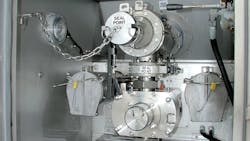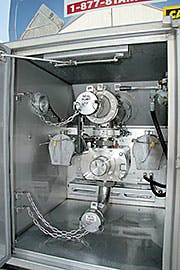Seal security, cleanout caps highlighted during tank cleaning session
THE Food and Drug Administration’s proposed rule on the Sanitary Transportation of Human and Animal Food will become a final rule by March 31, 2016.
It will establish criteria for sanitary transportation practices, including elements such as adequately cleaning vehicles between loads and properly protecting food during transportation. The rule was reviewed by members of the National Tank Truck Carriers Tank Cleaning & Environmental Council during Tank Truck Week held in Houston, Texas in late 2014.
Pete Nativo, vice-president of maintenance for Oakley Transport, said liquid bulk transportation has been out in front on the sanitary food hauling issue—leading rail and refrigerated truck operations—but proper seal security and reconciliation of seals during the transportation process is a critical factor that needs to be kept in the forefront for everyone in the food distribution sector.
He said Oakley Transport has compiled a seal procedure and policy to provide traceability of the security of seals.
“In today’s world, we have to put together some sort of quality control from cradle to grave,” he said. “We recently took on a director of quality control to follow seals from cradle to grave on trailers. We have a designated security official who orders seals and tracks all the numbers on seals, and ensures that they are monitored on each trailer.
“Sometimes we get a seal that has a misprint or numbers out of sequence and they have to go to the director of security operations and say, ‘There is a misprint.’ We still log that. We log every seal, even if it doesn’t get on a trailer. That’s part of the reconciliation. We found out early on that not all seals are perfect. Some have problems. If we don’t log bad seals, it will get out to the customer. If we don’t reconcile all seals, we’re not following them from cradle to grave.”
He said there is a tank wash logging and control process for seals, and the director of quality confirm that Oakley Transport procedures are being followed.
The bill of laden goes into the director of quality, and he looks at the log and follows each seal back from start to finish. Seals are packaged and only a certain amount of seals are given to the tank wash daily. They will record which ones they use.
The director of quality is going to reconcile if any seal was damaged. Notes are made and each seal is followed along the process.
“It took us awhile to figure out what length cable to use,” he said. “Where we do the sealing, in some cases it has to be 12 inches, and in some 15 inches. Our seals have 18-20 inches of cable, so we can use it on every seal point on the trailer. There are two seal points on the outside of cabinet. However, on the inside of the cabinet, we have seal points on anything that can be opened or where product can be tampered with.
“A lot of people say, ‘You have seal points on the outside of the cabinet, and that’s all you need.’ But we can’t do that in today’s world. Somebody could take the hinges off the cabinet and get in. So customers won’t accept just two seal points on the outside of the cabinet anymore. They want seals at every point where somebody could get in. We even have a seal that can go on the internal valve or where flanges can be taken apart. Somebody could take that flange off and possibly inject something into the product or contaminate the pump. We also have a seal point on the butterfly valve, just in case somebody were to take it off and inject a contaminent. It’s a lot more complicated inside the cabinet than just having seal points on the outside cabinet.
“Regarding the seal point in the internal pump handle, we drill a hole through the jack handle and also have a seal tab on the frame, so we seal it from the handle down to the frame so that nobody can open the internal jack even though the cabinet is closed. On top of the tank, we have a pressure-relief valve. We not only have a seal point where the nut holds it down, but also a seal for the gauge, because somebody could unscrew it and put something in there.”
Dan Wright
Vice-president of safety, Transport Service LLC
Wright, a member of the Cargo Tank Risk Management Committee (CTRMC), said he’ll probably go to his grave preaching about the need for eliminating cleanout caps on tank trailers.
“I know it’s controversial and there a lot of tank cleaners out there who say, Oh, my god, I can’t do that,’ ” he said. “But as tank cleaning processes evolve, and also the voodoo concoctions we come up to clean the chemicals we haul, we’ve done a lot better job.
“Can we do it? You guys are the industry leaders. Can we do it? There are a lot of carriers starting to go down this path of eliminating cleanout caps, so we have to create a better mousetrap and cleanout process.”
He said eliminating cleanouts has been discussed at every CTRMC general meeting. A lot of feedback has been given, but there has been no success yet in finding a feasible solution.
“Now, there are still products out there that probably will require cleanout caps for effective cleaning,” he said. “But 90% of the time, the products we have out there can be cleaned without putting a spinner down a cleanout cap. We own quite a few tanks washes, and with every one I go to, I never see anybody using the ends. They just go down the center, it goes through its wash, the guy looks down there, ‘Yeah, it looks good,’ and out it goes. He takes the cleanout caps and puts them in a big basket, washes them, and who knows what cleanout caps get put back on a trailer?
“You don’t always get the same ones that came in with the trailer. We have caps not being fitted properly. Even on some of the bolts and nuts and threads we’re getting from foreign countries—some of the cleanout caps being made in China—the specs are not very good. They aren’t the same. Do they fit properly? Do they stay tight? No.”
He said the feedback from previous CTRMC meetings has been clear: Without any new ideas, the topic is tabled.
“But I still think that as far as the elimination of cleanout caps, it’s been pretty controversial,” he said. “There are some guys jumping on it and saying they will do it. Other guys say, ‘We can never do this.’ I’m here to say, ‘Yes, we can.’ We can build roads and put people on the moon. We can eliminate cleanout caps.”
His question: “If we developed a new means of cleaning tanks—even ones hauling viscous products—compatible with inputs generally available at wash racks, affordable, not patented, or tied to one supplier, and not requiring cleanouts, would our industry support—or mandate—change?”
He presented the value proposition:
• Worker safety. “Priceless. If we have one guy fall off a trailer, whether a tank washer or mechanic, even when pressurizing the tank, that’s too much.”
• Less weight. “Does it weigh 250 pounds? Probably. By the time you put catwalks on there, and a nozzle.”
• Less cost. “As pricing goes up and labor goes up, that price will go up.”
• Less drag. “That means better mpg.”
• Less maintenance. “How much does it cost you to continually maintain cleanout caps and gaskets, and one load contamination? What is the real cost of cleanout caps you can’t maintain and get to?”
• Fewer spills. “That’s a big one for me. We’ve had some pretty expensive ones.”
• Less wash rack confined space work. “That’s a big one. We don’t want people on top of tanks. How do we clean them to make sure the product is out of the trailer? There’s new technology out there every day, and we challenge everyone to look for this new technology and eliminate this cleanout cap issue.”
• Fewer seals/load security risks. “If you look at foodgrade trailers, they don’t have cleanout caps on the end. And there are some pretty heavy products they clean, too. How many times do people climb up and seal those trailers? Every time you go to seal a trailer, from the time it leaves the tank wash to when it comes back, if your seals are on it, they leave them on. But if they change seals, then they put their seals on it. It causes a security risk.” ♦
About the Author
Rick Weber
Associate Editor
Rick Weber has been an associate editor for Trailer/Body Builders since February 2000. A national award-winning sportswriter, he covered the Miami Dolphins for the Fort Myers News-Press following service with publications in California and Australia. He is a graduate of Penn State University.



